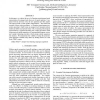Free Online Productivity Tools
i2Speak
i2Symbol
i2OCR
iTex2Img
iWeb2Print
iWeb2Shot
i2Type
iPdf2Split
iPdf2Merge
i2Bopomofo
i2Arabic
i2Style
i2Image
i2PDF
iLatex2Rtf
Sci2ools
ICASSP
2010
IEEE
2010
IEEE
Towards multi-speaker unsupervised speech pattern discovery
In this paper, we explore the use of a Gaussian posteriorgram based representation for unsupervised discovery of speech patterns. Compared with our previous work, the new approach provides significant improvement towards speaker independence. The framework consists of three main procedures: a Gaussian posteriorgram generation procedure which learns an unsupervised Gaussian mixture model and labels each speech frame with a Gaussian posteriorgram representation; a segmental dynamic time warping procedure which locates pairs of similar sequences of Gaussian posteriorgram vectors; and a graph clustering procedure which groups similar sequences into clusters. We demonstrate the viability of using the posteriorgram approach to handle many talkers by finding clusters of words in the TIMIT corpus.
Gaussian Posteriorgram | ICASSP 2010 | Procedure | Signal Processing | Unsupervised Gaussian Mixture |
| Added | 06 Dec 2010 |
| Updated | 06 Dec 2010 |
| Type | Conference |
| Year | 2010 |
| Where | ICASSP |
| Authors | Yaodong Zhang, James R. Glass |
Comments (0)

